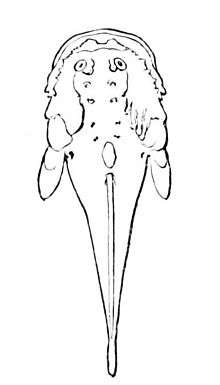Halobatrachus didactylus
| Halobatrachus didactylus | |
|---|---|
 | |
| Not evaluated (IUCN 3.1) | |
| Scientific classification | |
| Kingdom: | Animalia |
| Phylum: | Chordata |
| Class: | Actinopterygii |
| Order: | Batrachoidiformes |
| Family: | Batrachoididae |
| Genus: | Halobatrachus J. D. Ogilby, 1908 |
| Species: | H. didactylus |
| Binomial name | |
| Halobatrachus didactylus (Bloch & J. G. Schneider, 1801) | |
Halobatrachus didactylus, the Lusitanian toadfish, is a species of toadfish found along the Atlantic and Mediterranean Coasts of western Europe and western Africa. This species grows to a length of 50 centimetres (20 in), and has venomous spines that can pose a danger to humans. This species is of minor importance to local commercial fisheries. Locally, it is known as gripau (Catalan), charroco, encharroco, xarroco (Portuguese), and pez sapo (Spanish)).[1]
The fish is also known to make a variety of noises, such as whistles, grunts, croaks, and a boatwhistle that is used both to attract females, as well as keep intruding males away.[2]
References
- ↑ Froese, Rainer and Pauly, Daniel, eds. (2012). "Halobatrachus didactylus" in FishBase. April 2012 version.
- ↑ Mary Bates (1 April 2015). "Zoologger: Bagpiper fish keeps intruders away with song". New Scientist. Retrieved 4 April 2015.
This article is issued from Wikipedia - version of the 8/2/2016. The text is available under the Creative Commons Attribution/Share Alike but additional terms may apply for the media files.